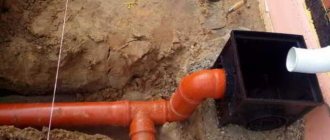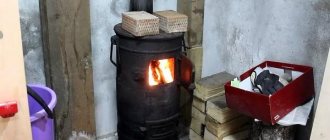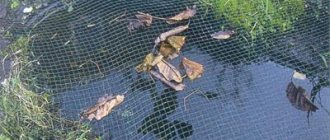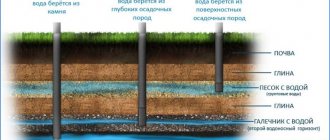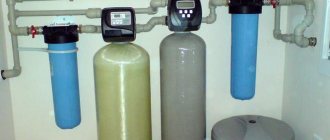One of the mandatory conditions for the uninterrupted operation of autonomous water supply is the protection of communications from icing in winter. This problem can be solved by diverting the system below the dangerous level of soil freezing, as well as connecting the pipe coming from the well pump through an adapter.
We will tell you what this device is and what advantages it has in comparison with the construction of a caisson. You will learn how to correctly install a well adapter with your own hands, how to connect it to the pipeline and at what depth. Taking into account our advice, you can install it yourself without any problems.
Design features of the device
The downhole adapter is a special device. It ensures a hermetically sealed entry of water supply pipes through the casing when installing a non-freezing water supply system. Essentially, the adapter is an angle connector.
The principle of operation of the adapter is that it redirects the water rising up the well shaft into the pipeline leading to the house, which is located below the freezing level of the ground
Although downhole adapters have a fairly simple design, equipping a well with their use is associated with many features. This specificity largely determines the service life of the hydraulic structure.
The main elements of the adapter are the outer and inner parts.
Internal flow part
Externally, this part of the device resembles a tee. One of its sides is blank. It is equipped with technical threads required for joining the two parts of the adapter. The other part is connected to the pipe leading to the deep-well pump. The central branch of the tee-like connection is equipped with the second half of the general connection of the dovetail design.
The reverse side of the holder is equipped with an annular groove intended for a rubber gasket, as well as protrusions for pressing the wedge of the mating part
Its installation is carried out in the hole of the casing pipe, securing it with a union nut equipped with a sealing ring.
Rubber seals are designed to seal the well from the ingress of groundwater. The first seal is placed on the inner surface of the holder plane, the second - between the outer wall and the union nut.
External mate
This is a compact threaded pipe. It is connected to the HDPE pipe and to the discharge pipe of the pump, and is connected to the main part by threading a special rod into the wedge slide. In addition to the wedge, it is equipped with an annular groove and two fittings with internal threads.
The main feature of the device is the strong connection of the external and internal elements, called the “dovetail”.
Thanks to this design solution, a hermetically sealed connection is obtained between the vertical and horizontal sections of the water pipeline with their subsequent removal to the outside through the casing
The intermediate element nipple, which is a single structure with a holder, is intended for connecting the water supply to the pump.
Purpose of the downhole adapter
The main element of any well is the casing, assembled from sections of polymer, steel pipes or combinations thereof by threaded connections. To extract water from a deep shaft, submersible or surface pumps with a long pressure pipe are used, which are placed inside the borehole channel. The main problem in this case is the operation of the water supply system in winter - to prevent freezing of the source and equipment, it is usually placed underground to a depth of 2 m.
Related article: How to defrost water pipes.
To install a water pipe into a well at such a depth, two main methods are used. In the first case, a deep hole is dug around the casing and a closed chamber made of various materials, called a caisson, is placed in it. The column is cut off, and the pressure pipeline is inserted through its top using a well cap. In this case, the electric pump can be placed both inside the well (submersible models), tied by a cable to the head, and outside as part of a pumping station with a pressure pipeline lowered into the channel.
When using a downhole adapter, a deep hole is dug near the casing string in such a way that a specialist carrying out installation work can comfortably fit in it. An adapter is cut into the side wall of the upper casing at a depth below the freezing point, through which a pressure pipeline is passed into the well and connected to the water supply line going into the house. The casing at ground level is covered with a lid to which a submersible electric pump is attached.
Thus, the adapter allows you to connect the pressure pipeline from the submersible electric pump to the water main at a depth below the freezing point. It can also be used with a surface pump installed at some distance from the well source in a house or outbuilding.
Structural design and installation diagram of the adapter
Advantages and disadvantages of “adapter” technology
The technology of constructing a well using an adapter is a worthy alternative to installing a caisson. And the reason for this is a number of undeniable advantages that the downhole adapter has:
- Affordable price . The price of the adapter is many times cheaper than the caisson, thanks to which a wide range of buyers can afford to purchase and install the device on their site.
- Easy to install. It does not require the use of welding equipment or the welding skills of the performer. Excavation work is carried out to a minimum - only along the connected water supply branch. Even a novice master can handle the installation of a downhole adapter.
- High system tightness . The adapter links are adjacent extremely tightly to each other. The sealing ring of the device is quite capable of withstanding a system pressure of 7-8 atmospheres. The design, which provides for disassembling the flow part of the device inside the casing pipe, will ensure the operation of the device even in the presence of a leak.
- High load-bearing capacity. Depending on the thickness of the walls of the device and the material of manufacture, all sections of the adapter thread are able to withstand connected communications and a submersible pump, the total weight of which reaches from 200 to 800 kg.
- Aesthetic qualities . Thanks to the possibility of hidden installation, a well equipped with an adapter will be practically invisible on the site. This is especially true for owners who are afraid of theft of the pump.
Due to the high tightness of the device, it can be safely used when constructing a system in areas with high water typical for the off-season, as well as those located in close proximity to underground communication lines.
Installing an adapter is a win-win option in case of irregular use of the well and “freezing” of the hydraulic structure for a long period
But, like any device, this very useful device is not without its drawbacks. For example, when installing a downhole adapter, it is impossible to provide quick access in case of need for maintenance and repair work.
The tightness of the joining of parts of the downhole adapter can be guaranteed only if preventive treatment of external and internal gaskets is carried out, as well as their timely replacement.
For example, an external gasket in direct contact with the ground becomes unusable after use for 2-3 years. And to carry out this work, you have to dig a pit, which is not always possible.
Installing an adapter limits the possibility of connecting additional sources of water intake from the well, for example, for watering the site
Brass and other metal alloys used in the manufacture of cheap adapters oxidize during use. As a result, parts are often jammed at the joints, which complicates the process of removing the pump.
For this reason, experts advise purchasing adapters made of bronze, stainless steel and specialized “food” alloys. These oxidation-resistant metals will last from 20 to 50 years.
In European countries today only adapters made of food alloys, such as DZR or Sanitary Brass, are used. But domestic GOSTs allow the use of stainless, bronze and brass devices due to the fact that the area of contact of its elements with water is negligible.
Another vulnerable point is the connection of the adapter with the drainage pipe and hose on which the pump is installed.
The key reason for the possible depressurization of structural connections is that the connecting elements are made of different materials
The connecting elements of the system react differently to the effects of temperature and moisture, and also have different periods of wear and aging. Therefore, experts advise, if possible, the pipe leading from the well to the house should be made of stainless steel.
Briefly about the main thing
Wanting to protect the water supply from freezing, spending a minimum of money on it, it is removed from the well through an adapter installed in the casing pipe underground. This method preserves the tightness of the source, reduces the time to put the well into operation, but excludes free access to the hydraulic unit for inspection and repair. However, if the installation technology is followed, its service life is at least 20 years, and such rare “excavations” should not create problems.
Ratings 0
Manufacturers
When choosing an adapter for a well, you need to pay attention to the manufacturer, since the performance of the mechanism depends on it. It is worth considering the most popular manufacturers of downhole adapters.
- Debe Pumpar manufactures adapters that meet the pan-European quality standard. Such mechanisms have a housing that resists rust for quite a long time, and can also be equipped with thermal protection, thanks to which the adapter can be installed above the soil freezing level.
- Baker manufactures stainless steel well adapters that are primarily used for potable water piping systems. This mechanism is considered high quality, which allows the use of fittings for home water structures.
- Vinkell produces high quality bronze products. The smallest pipe diameter to which the adapter can be connected is 12 cm. The option of installation is provided next to the sewer system or inside the foundation.
The process of constructing a well with a caisson: stages of work
Arranging a water source with a caisson is a complex process that requires equipment and specialists. The work is labor- and time-consuming. There are a number of operations to be performed:
- A hole for the casing is cut in the bottom of the caisson. The diameter is 10 mm larger than the casing size.
- Nipples for supplying pipes and cables are welded into the sidewalls.
- Dig a trench under the camera. The depth is such that the neck of the caisson after installation rises 20 cm above the surface. The length and width of the pit are required to be slightly larger than the chamber for ease of installation.
- The casing pipe is cut off near the ground and a caisson is installed. The position is adjusted and the casing is hermetically sealed. Cables and pipes are introduced.
The process is complex and takes a lot of time.
Some tips
Having decided to equip a well with an adapter (in retail chains they are called Pitless adapters), you get a reliable water supply system and save on the timing of the work and the cost of its implementation. However, when purchasing it, you must remember the following:
- In order for the product to maintain its tightness throughout its entire service life and guarantee the possibility of repeated installation and dismantling of the deep-well pump, it must be of high quality. Do not buy adapters from little-known manufacturers that do not have a manufacturer's warranty.
- Having decided to purchase a Pitless adapter, be sure to check with the seller how difficult it is to find spare parts for this product in retail chains, first of all, o-rings and a removable part assembly. What is the probability that in a couple (or better, in five) years this product will still be produced.
- Having settled on this option, you will need to place all the equipment of your water supply system in the house itself and, preferably, in a separate room.
If you also have a main water supply, then it is useful to install an avk flanged valve to be able to shut it off. Depending on the situation, you can choose the source of water supply.
What tools will you need?
To carry out excavation and installation work yourself, you will need a set of tools:
- bayonet shovel;
- scrap (if there is rock or gravel soil);
- yardstick;
- extension cable;
- electric drill with a core cutter;
- grinder (grinder);
- gas adjustable wrench;
Auxiliary materials required for work:
- sandpaper;
- water-repellent sealant;
- tightening clamps;
- connecting fittings.

